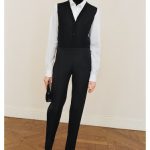All that glitters is not gold—especially in the beauty industry. Here, the shimmer contains Botox, Juvéderm, and highly advanced filters that create an illusion of perfection. While the innovation behind injectables is impressive, as is the case with any invasive or noninvasive treatment consumers are advised to do their research on the procedures and ingredients being injected into their face and body. It’s especially important to find a trustworthy medical professional to deliver this information.
That’s where Dr. Kami Parsa comes in. One of the most distinguished plastic surgeons of the moment, the Iran-born, board-certified UCLA and USC scholar is behind groundbreaking surgical innovations that use fat transfer as an alternative to fillers. We sat down with Parsa for an honest discussion about fat transfers vs. fillers and treatments to avoid (eyebrow waxing is a no-no while microneedling is beneficial) that will up your long-term beauty game.
Fillers are known for wearing off over time, which for people looking for a more permanent fix isn’t ideal.
We haven’t found the perfect filler yet, period. In order for filler to be exceptional it needs three qualities: the perfect facial filler to replace lost volume, “The Holy Trinity,” and—bear with us while we get technical here—first, it has to be nonimmunogenic, which means your body doesn’t have an allergic reaction to it; second, it needs to be biocompatible, which means it has to be compatible with your natural tissue; and third, the filler has to be biodegradable. The body has to be capable of breaking it down.
When hyaluronic acid fillers like Restylane first came to the market in the U.S. 20 years ago, they were marketed as the perfect volume placement substance because they are “naturally” found in our tissue without causing any reactions—the body would just absorb them over time. Those statements would be true if we injected purified hyaluronic acid. The problem with the purified hyaluronic acid is that it is not stable, and it gets absorbed within two to four days. To overcome this problem of rapid degradation, filler manufacturers started “cross-linking” the HA fillers, which makes them more stable and allows them to last longer. Each company—Voluma, Volure, Juvéderm, etc.—started developing their own unique blend of cross-linked HA.
Essentially, they were all the same but with different additives?
Yes. Then you have to ask, do hyaluronic acid fillers in their current form meet the holy trinity definition of biodegradable, non-immunogenic, and biocompatibility? Not fully. We now know through MRI studies that these HA fillers last many years, sometimes 10 to 15 years or longer. Many studies have shown acute or chronic inflammation associated with some HA fillers. That’s most likely because our natural immune system is not used to seeing the cross-linked HA that is not usually found in our tissue. We recently completed a study that showed fillers can block the lymphatics around the eyes and midface.
That’s concerning. Even more troubling: what’s behind so-called “pillow faces” with too much filler that look nothing like the original person?
Overfilling is also a huge problem. Over the past 20 years, we’ve literally looked at the aging face as a volume-depletion-only problem, which is not true. We lose volume as we age, but we also lose bone, collagen, and elastin. There is also this continuous sagging of tissue around the face as we age. The industry has been running with the “volume loss only” narrative and any provider who can hold a needle has taken a weekend course, added “master injector” to their name, and started filling every patient who wants to look a little refreshed. Another issue is that the filler manufacturers have been marketing these products as only lasting 6 to 12 months, which is not true.
Fast-forward to today and we have this issue of overfilled faces. Am I against all fillers? No. I certainly think they still play a role in the antiaging treatment—but to an extent. For the right patient, they work beautifully. When it comes to fillers around the eyes, in my opinion most patients are not good candidates.
Walk me through the process of a fat transfer.
Fat transfer is a surgical process where, under local or general anesthesia and using sterile techniques, a small amount of fat is liposuctioned (usually from the patient’s abdominal or flank region) and reinjected to the area of the body experiencing volume loss. The upside of fat transfer is that it is from your own body, and you are replacing like with like. It also has a lot of stem cells, which are key in the regenerative antiaging process. The downside is that it is a surgical procedure and highly technical. By that I mean the surgeon performing the procedure needs to know the proper way of processing the fat and be meticulous with the injection and placement. Fat injected superficially can lead to lumps and bumps.
Who is not a candidate for fillers around the eyes?
Lower-eye bags are usually a combination of hills and valleys—the hills are caused by protruding fat, and the valleys are caused by hollows. If we only addressed the under-eye bags, most patients would be left with hollow-looking cheeks after surgery, which wouldn’t create harmony in the face. Generally speaking, anyone who has fluid retention syndrome (face swells in the morning on and off), patients with chronic allergies or autoimmune disorder, patients with excessive eye bags and not hollows, patients with very loose skin around the eyes, and patients looking for a long-term fix are not the best candidates.
In my practice, unfortunately, we are seeing a lot of patients who have had issues related to fillers around the eyes. I want everyone who is thinking of getting fillers around the eyes to make sure they do their research and at least consult with people who are experts in this field. It doesn’t hurt to get a few opinions.
How do you know you need blepharoplasty (an upper and lower eyelid lift) or just a brow lift?
Most patients that come in complaining of heavy upper eyelids say they “can’t wear my makeup anymore,” or are tired of being told they look tired. These patients are either in need of an upper eyelid blepharoplasty or a brow lift.
The skin around the eyelids is the thinnest in our body. As we live life, rub our eyes, put makeup on, remove makeup, wash our face, with age and through exposure to sun and environment, that skin stretches. So a blepharoplasty is performed when this thin skin is stretched. This procedure can be done under local anesthesia by removing the extra skin on the upper eyelids to create a more youthful appearance.
At times, the brows have either drooped or the patient is born with low-set brows—in this case, a brow lift is the better choice. The brow position is different for men and women. The masculine brow is usually flat, whereas a feminine brow is more arched laterally.
Despite all of this, it is my deep belief that real beauty comes from within. Not everyone needs to perform surgery to feel good about their appearance. What are your top preventative care recommendations to avoid eye wrinkles?
First, make sure you don’t rub your eyes. It’s easier said than done, but it does matter. The skin around the eyes is the thinnest on the body. Rubbing the eyes irritates the skin in this area. When removing makeup, it’s best to find a makeup remover that allows the makeup to easily come off. When removing makeup, try to pat the area rather than rubbing it. You also need a good skincare routine with retinol and SPF.
What are some beauty treatments that could end up doing more harm to the eye area, causing it to age faster?
I’m also not a fan of waxing your brows, as that stretches your thin upper eyelids. Threading or just plucking might be a better option. The most important thing is to listen to your eyes. By that I mean if you’re using a product, cleanser or makeup and your eyes are irritated—don’t ignore it. I see tons of patients who continually wear the same makeup, eyeliner, eyelash serum or eyelash extension, even though it bothers them. This chronic irritation will ultimately take its toll on your eyelids, resulting in dark circles, eye bags or droopy eyelids. If you wear contacts, don’t sleep with them (more people disregard this advice than you think) and make sure you have periods of rest from contacts. Using artificial tears is also key.



